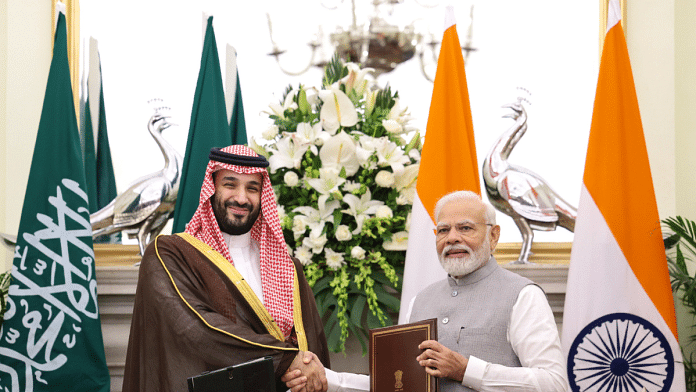This was a rare gesture toward the leader of a non-Islamic partner country, reflecting the importance of the bilateral bond.
Interestingly, Modi will be landing in Jeddah, a major economic hub in Saudi Arabia. Its strategic location on the Red Sea places it on par with Mumbai in terms of economic significance and international engagement. Naturally, the key focus areas of the visit will be the economy, energy, and investments. The depth of collaboration in these areas, along with growing ties in defence, says a lot about why Jeddah was chosen as the landing point.
An evolving strategic partnership
India and Saudi Arabia formalised their Strategic Partnership in 2010, and the relationship has expanded rapidly since then. In 2019, the strategic partnership reached a new high with the signing of the Strategic Partnership Council agreement, which established a high-level mechanism to steer the India-Saudi Arabia relationship.
The council has two subcommittees—the Committee on Political, Security, and Cultural Cooperation and the Committee on Economy and Investments—and four functional levels of engagement, with the apex being the leader-level summits. PM Modi is expected to co-chair the council’s meeting during his forthcoming visit.
Over the past decade, the strategic partnership has grown stronger and more dynamic, spanning strategic domains—from rising investment commitments to expanding defence cooperation and a marked increase in high-level exchanges.
Saudi Arabia is India’s fifth-largest trading partner, and bilateral trade reached more than $52 billion in 2022-23, growing 23 per cent. Petroleum products are among the top high-value items in India’s import itinerary from Saudi Arabia. India’s comprehensive trade with the Kingdom accounted for 4.53 per cent of the total trade in 2023-24.
With ongoing instability in Europe and West Asia, India needs a secure supply of energy, and Saudi Arabia is well placed in this regard. It currently fulfils India’s crude oil needs. Saudi Arabia ranks as India’s third-largest crude supplier after Russia and Iraq, and the third-largest LPG sourcing destination, accounting for approximately 20 per cent of its total LPG imports globally.
While trade has emerged as a significant bridge between the two, Saudi investments in India have also become a vital pillar of the bilateral partnership. During PM Modi’s visit to Riyadh in 2019, the Kingdom pledged to invest $100 billion in India.
However, this ambitious commitment is still a work in progress, with current Saudi investments standing at approximately $10 billion only—an issue that is expected to come up during the discussion.
Apart from trade and investment, defence has emerged as a key mainstay of the India–Saudi Arabia strategic partnership. With India easing regulations to encourage private sector participation in defence manufacturing, the country is increasingly being recognised as a rising global player in the sector.
In February 2024, Indian defence firms took part in the World Defence Show held in Riyadh, where Munitions India Limited signed a significant contract worth $225 million to supply artillery ammunition to Saudi Arabia.
On the security cooperation front, the Kingdom recognises India’s growing role in the Arabian Sea and the Red Sea, especially in securing the critical sea lanes of communication from piracy and other menaces.
Between December 2023 and January 2024, India emerged as the first responder in more than 15 incidents of piracy, which involved swift actions against the hijackers on the high seas. Concerns like the Houthis’ active threat in the region have been a key concern for both. This recognition of shared strategic concerns led to the initiation of the Al-Mohed Al-Hindi, a joint maritime exercise between India and Saudi Arabia in 2021—the two navies conducted the inaugural edition that year, followed by a second exercise in 2023.
Preparations for the next iteration of the joint maritime exercise are reportedly already underway, reflecting growing defence cooperation and mutual trust in the maritime domain.
Also read:
Realising the potential of IMEC
Beyond the bilateral, PM Modi’s visit will also be India’s chance to reiterate its commitment to a key Middle Eastern partner on the India-Middle East-Europe Economic Corridor (IMEC)—which comprises an Eastern Corridor connecting India to the Gulf region and a Northern Corridor connecting the Gulf region to Europe. It includes a railway and ship-rail transit network and road transport routes, launched on the sidelines of the 2023 G20 Summit in India.
Despite initial scepticism surrounding the project’s viability since its launch, India has consistently highlighted IMEC in its engagements with European and West Asian partners. It found prominence during the visit of European Commission President Ursula von der Leyen and the EU College of Commissioners to India in February this year. Such reiterations signal a strong and steady commitment.
Additionally, the new Trump administration, which does not seem to be a huge fan of minilateral and multilateral alliances, has also not shied away from including IMEC as a key agenda item in joint statements, most recently, during the Trump-Meloni meeting at the White House, where the corridor received notable mention.
Therefore, a collective push—from East to West—toward realising IMEC would serve the shared interests of all participating countries.
To conclude, there remains little doubt that today’s Saudi Arabia is looking beyond oil as the only cardinal force driving its bilateral partnerships worldwide, including with India. Riyadh is looking to broaden its economy through investments in big-tech, green energy, pharmaceuticals, automotive, semiconductors, artificial intelligence, and data centres, among others, opening unlimited possibilities for India to engage.
Rishi Gupta is the Assistant Director of the Asia Society Policy Institute, New Delhi. He writes on the Asia-Pacific affairs, strategic Himalayas, and South Asian geopolitics. He tweets @RishiGupta_JNU. Views are personal.
(Edited by Aamaan Alam Khan)
var ytflag = 0;
var myListener = function() {
document.removeEventListener(‘mousemove’, myListener, false);
lazyloadmyframes();
};
document.addEventListener(‘mousemove’, myListener, false);
window.addEventListener(‘scroll’, function() {
if (ytflag == 0) {
lazyloadmyframes();
ytflag = 1;
}
});
function lazyloadmyframes() {
var ytv = document.getElementsByClassName(“klazyiframe”);
for (var i = 0; i < ytv.length; i++) {
ytv[i].src = ytv[i].getAttribute('data-src');
}
}








